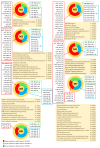Long Non-Coding RNAs Modulate Sjögren's Syndrome Associated Gene Expression and Are Involved in the Pathogenesis of the Disease
- PMID: 31480511
- PMCID: PMC6780488
- DOI: 10.3390/jcm8091349
Long Non-Coding RNAs Modulate Sjögren's Syndrome Associated Gene Expression and Are Involved in the Pathogenesis of the Disease
Abstract
Primary Sjögren's syndrome (pSjS) is a chronic systemic autoimmune disorder, primarily affecting exocrine glands; its pathogenesis is still unclear. Long non-coding RNAs (lncRNAs) are thought to play a role in the pathogenesis of autoimmune diseases and a comprehensive analysis of lncRNAs expression in pSjS is still lacking. To this aim, the expression of more than 540,000 human transcripts, including those ascribed to more than 50,000 lncRNAs is profiled at the same time, in a cohort of 16 peripheral blood mononuclear cells PBMCs samples (eight pSjS and eight healthy subjects). A complex network analysis is carried out on the global set of molecular interactions among modulated genes and lncRNAs, leading to the identification of reliable lncRNA-miRNA-gene functional interactions. Taking this approach, a few lncRNAs are identified as targeting highly connected genes in the pSjS transcriptome, since they have a major impact on gene modulation in the disease. Such genes are involved in biological processes and molecular pathways crucial in the pathogenesis of pSjS, including immune response, B cell development and function, inflammation, apoptosis, type I and gamma interferon, epithelial cell adhesion and polarization. The identification of deregulated lncRNAs that modulate genes involved in the typical features of the disease provides insight in disease pathogenesis and opens avenues for the design of novel therapeutic strategies.
Keywords: gene module; long non-coding RNA; primary Sjögren’s syndrome; protein–protein (PPI) network; signaling pathway.
Conflict of interest statement
The authors declare no conflict of interest.
Figures




References
-
- Shiboski C.H., Shiboski S.C., Seror R., Criswell L.A., Labetoulle M., Lietman T.M., Rasmussen A., Scofield H., Vitali C., Bowman S.J., et al. 2016 American College of Rheumatology/European League Against Rheumatism classification criteria for primary Sjögren’s syndrome: A consensus and data-driven methodology involving three international patient cohorts. Ann. Rheum. Dis. 2017;76:9–16. doi: 10.1136/annrheumdis-2016-210571. - DOI - PubMed
LinkOut - more resources
Full Text Sources
Other Literature Sources

